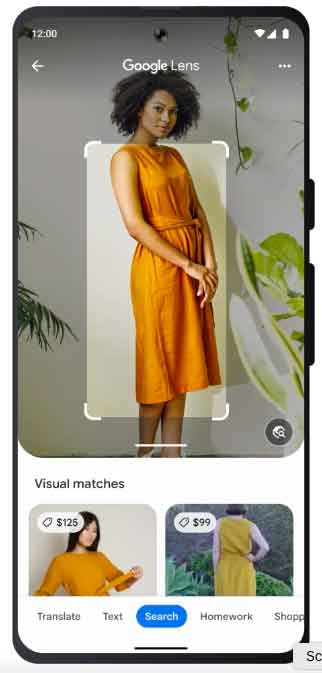You’re likely already familiar with the idea of visual search. The technology uses machine learning and image recognition to get results from images, not keywords or phrases. The rise of visual search has had an impact on SEO practices–not only providing new opportunities for optimization but also reshaping how we think about content creation and curation for websites and social media platforms.
It is important to shift our thinking to understand what types of visuals are relevant. These visuals could be product-based searches, unique angles, or color/texture combinations. This will ensure that your website is maximizing its potential benefits!
Introduction to Visual Search
Visual search has emerged as the next frontier in the SEO industry, revolutionizing how we discover and interact with content. It refers to a technology that enables users to search for information, products, or content using images rather than text-based queries. Instead of typing keywords into a search engine, users can take a photo, upload an image, or even use a screenshot to initiate a search. The underlying technology, powered by computer vision and artificial intelligence, analyzes the visual attributes of the image, such as colors, shapes, patterns, and objects, to understand the user’s intent and deliver relevant search results.
Visual search has become increasingly popular due to its ability to provide more intuitive and efficient search experiences. It allows users to find information about objects, places, or products they encounter in the physical world simply by pointing their device’s camera at them. For example, users can take a picture of a piece of furniture to find similar designs, snap a photo of a landmark to learn more about it or capture an image of a product to find online shopping options.
Understanding the Technology Behind Visual Search
Artificial intelligence and machine learning play pivotal roles in refining this innovative technology. AI algorithms analyze image data with remarkable accuracy, identifying patterns while rapidly improving over time due to continuous self-learning capabilities.
Deep learning models serve as the framework for these AI-driven systems by training neural networks that can effectively process vast amounts of complex information. These networks help decipher object recognition within images, providing context and relationships between elements and even comprehend abstract concepts such as sentiments or emotions conveyed through visuals. Moreover, powerful tools like Google TensorFlow facilitate improved code development for implementing advanced deep-learning techniques in real-world applications.
This open-source library systematically enables efficient handling of large-scale neural network training processes essential for fine-tuning visual search engines’ performance. Understanding these technological underpinnings contributes significantly towards leveraging their benefits when optimizing SEO practices concerning visual searches – a vital aspect your business should not overlook at any cost!
The Evolving Need for Visual Search
As the digital world advances, the need for visual search evolves alongside it due to changing consumer habits and preferences. Users crave more interactive experiences, making this technology increasingly relevant in various industries, particularly retail, fashion, and home décor.
A critical driving force behind its growth is the desire for instant gratification; users want quick access to information without typing out lengthy queries. Additionally, mobile device usage has skyrocketed over recent years, directly impacting how consumers interact with online content. With smartphone cameras constantly improving in quality and functionality, engaging with visuals through mobile devices becomes effortless and enjoyable.
To stay competitive within this new landscape of SEO practices shaped by visual search advancements, brands must continuously adapt their strategies according to these emerging trends. By optimizing image-based content while incorporating user-friendly interfaces, businesses can capitalize on customers’ attraction toward visually appealing platforms, ultimately increasing engagement and conversion rates overall.

Impact of Visual Search on SEO Practices
Visual search technology’s emergence has profoundly impacted search engine optimization practices. Optimizing for visual search has become a crucial aspect of a comprehensive SEO strategy as search engines evolve. Here are some key ways in which visual search has influenced SEO practices:
- Image Optimization: With visual search, images play a more significant role in search results. Optimizing images for search engines is essential to ensure they appear in relevant visual search results. This includes using descriptive file names, alt tags, and captions accurately describing the image content.
- Structured Data Markup: Implementing structured data markup, such as schema.org, helps search engines better understand and interpret the content of images. By providing additional information through structured data, businesses can increase the chances of their images appearing in visual search results.
- Visual Content Creation: To capitalize on visual search, businesses need to create high-quality visual content that is relevant, engaging, and optimized for search engines. This includes creating visually appealing product images, infographics, videos, and other visual assets that align with user search intent.
- Mobile Optimization: Visual search is predominantly used on mobile devices. Therefore, optimizing websites and content for mobile devices is crucial. This involves ensuring responsive design, fast loading speeds, and mobile-friendly user experiences to enhance visibility and engagement in visual search results.
- User-Generated Content: Encouraging user-generated visual content, such as customer images and videos, can enhance visibility in visual search results. User-generated content provides authenticity and social proof, attracting both search engines and users.
- Local SEO and Visual Search: Visual search has a strong connection to local search. Optimizing images and content for local SEO, including location-based keywords and business information, can increase visibility in visual search results for location-specific queries.
- Voice Search and Visual Search Integration: Voice search is closely intertwined with visual search. Combining voice-activated devices with visual search capabilities can create a more seamless and intuitive search experience. Optimizing for voice search queries that involve visual content can help businesses stay ahead in this dynamic landscape.
To maximize the benefits of this emerging trend, marketers must optimize their online presence for image-based searches by providing high-quality visuals accompanied by accurate metadata such as descriptive alt-texts and filenames. Furthermore, including structured data like Schema markup enables search engines to better understand your imagery.
Implementing responsive web design ensures user satisfaction across varying devices while maintaining accessibility standards critical in achieving higher rankings on SERPs (search engine results pages). Fostering an engaging user experience with rich content that resonates with target audiences ultimately boosts traffic and improves brand visibility. Remember that website speed is pivotal since slow-loading images may deter potential customers from interacting further; hence, optimizing these elements is paramount.
Benefits of Integrating Visual Search with SEO Strategies
Integrating visual search with your SEO strategies offers numerous advantages to boost online visibility and user engagement. By optimizing images for visual searches, businesses can tap into a rapidly growing audience who prefer this technology over traditional text-based queries. Optimizing visuals improves the accuracy of results and increases brand exposure, leading to higher click-through rates and potential conversions.
Incorporating visual search as part of an omnichannel marketing approach allows for seamless cross-platform experiences that cater to various customer preferences. This fosters loyalty among users by providing them with tailored content based on their unique needs or interests. Moreover, utilizing image recognition tools like Google Lens helps establish credibility about products or services through accurate identification within photos captured from real-world contexts.
Ultimately, combining well-crafted visuals alongside strategic keywords is essential in staying ahead amidst ever-evolving digital trends while ensuring that relevant information reaches target audiences effectively. This makes it indispensable when aiming for optimal success within competitive marketplaces today.
Challenges for Optimizing Content for Visual Searches
Optimizing content for visual searches presents a unique set of challenges that require innovative solutions. First, large volumes of high-quality images must be provided and properly tagged with relevant metadata.
This aids in accurate indexing by algorithms and enhances the search experience for users. Integrating well-structured data into your website’s code improves image recognition accuracy and boosts overall SEO effectiveness. Secondly, staying abreast of advances in machine learning technology is essential as these developments will shape the future course of visual search capabilities.
Keeping an eye on changes within major platforms like Google Lens, Pinterest Lens, or Bing Visual Search can help you adapt quickly to any shifts in optimization requirements. Lastly, striking a balance between optimizing text-based elements while incorporating visually-rich media may pose difficulties when designing web pages. Doing this without overwhelming site visitors or compromising load times is necessary.
By carefully evaluating user needs and emerging trends related to visual searching technologies, businesses can optimize their digital strategy accordingly, paving the way for improved online visibility and success.
Short & Long Term Opportunities with Visual Searches
In the short term, businesses can enhance the user experience by incorporating visually appealing images alongside well-crafted content.
This approach captures users’ attention and encourages social sharing, driving more traffic to the website. Long-term benefits include staying ahead of competitors who have yet to adapt their marketing strategies for a world driven increasingly by image-based searching. As search engines continue investing in machine learning and artificial intelligence technologies that power visual search algorithms, early adopters position themselves as industry leaders while reaping enhanced SEO results from this growing trend.
By capitalizing on these emerging possibilities, businesses can set strong foundations for future success. This could be done by improving existing product imagery or creating captivating visuals for blog posts and articles. Doing this will allow them to be prepared to face advancements in the field of visual search technology in the future.
Saturation and Competition: Considerations to Keep In Mind
As the adoption of visual search increases, so does competition among businesses vying for visibility. To stay ahead in this evolving landscape, you must consider standard SEO techniques and optimize your images effectively. Pay close attention to image quality; high-resolution visuals are crucial since they directly impact user experience and search engine indexing.
Furthermore, select visually appealing photos that represent your brand or product accurately while capturing users’ interest swiftly. Properly label each file with relevant keywords and include concise yet informative alt text descriptions following accessibility guidelines. Diversifying content across various platforms, such as social media channels, can help increase exposure while reducing saturation risks on any single platform.
Staying updated with emerging trends in technology and consumer behavior patterns is a great way to position yourself within the competitive digital market. This strategy can help to optimize your content, tailoring it specifically for a rapidly growing segment focused on visual searches. Ultimately, this will increase your overall online presence.
What Is Required to Stay Ahead With Google Visual Search
Prioritize image optimization for your website. Focus on high-quality visuals that convey the desired content accurately and effectively.
Implement descriptive filenames, alt text, and structured data markup such as schema.org tags for images and captions to increase visibility in traditional text-based searches and visual search results. Embrace responsive web design techniques (such as mobile-first) to ensure a consistent user experience across all devices. Regularly monitor advancements in machine learning algorithms powering visual search engines to fine-tune your approach over time.
Lastly, invest resources into staying informed about future algorithm updates. These developments may provide valuable insights into optimizing SEO practices catering to improved performance within emerging verticals enabled by cutting-edge deep neural network technology driving modern visual search platforms.
Visual search has revolutionized the way people find and research information online. SEO practices are now focused on optimizing content for image-based queries and providing more detailed descriptions about images to increase visibility in results pages. This technology is gaining popularity quickly, driving businesses to focus their efforts on creating visually appealing pictures that better engage users while improving SEO rankings at the same time.
Businesses must also use visual analytics tools that can measure click rates from various search engines such as Google Images or Pinterest Lens. Investing in this new form of marketing will help companies establish a competitive edge against competitors by getting ahead with cutting-edge technologies tailored toward long-term success.








